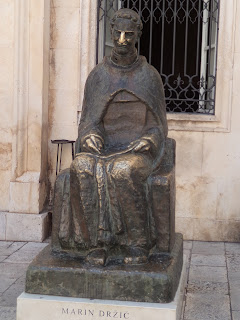July saw some lovely weather and we were able take some walks. Because it was so hot, shady paths had the most appeal. This path is at one side of Oaks Park, which is close to where we used to live. It took us several goes before we were able to find the whole path, it isn't very well signposted and the maps provided on the signboards in the park aren't entirely helpful either. Perhaps we need an Ordinance Survey map!
On an even hotter day at the weekend when we paid another visit to the shady paths in Oaks Park, we found the whole area very crowded. There seemed to be an event at the adjacent lavender farm, and, though we found it too hot in the sun, we managed it for long enough to take in this amazing sight of the lavender fields, just a sea of purple. Crowds of people were walking amongst the lavender flowers, and I imagine the perfume would have been almost overwhelming.
The incredibly hot weather didn't last for very long, so we were able to take some more testing walks. This one, on the Titsey Estate, is extremely steep so it's hard work in the heat. It's very shady though, so views are few and far between. This one is looking down across the estate towards the south. Titsey House is on the left, and just behind it you can see the spire of the church which a previous owner had had moved because he didn't like the worshippers passing too close to his house!
We also discovered a new circular walk, near Godstone, thanks to a book Paul picked up in a second-hand bookshop. The walk begins by being very interesting, taking a path beside some ponds close to the village. These ponds were previously associated with the manufacture of gunpowder, starting in the sixteenth century.
The ponds originally belonged to Ivy Mill and Leigh Mill which were powder mills producing gunpowder. They were started by George Evelyn, grandfather of John Evelyn, the Diarist. He apparently learned the secret formula for making a cheap form of Saltpeter, allegedly from a German spy. About 1556, Queen Elizabeth I granted him the monopoly for the manufacture of Gunpowder. For this purpose, he added Leigh Mill to his already extensive ownership of local mills. At one time, he was the only person in England manufacturing gunpowder.
There are other ponds locally, some of which we passed, and we suspect they were perhaps formerly gravel pits or stone quarries. Stone quarrying was said to have been an important industry for Godstone in the 18th and 19th centuries, but had declined in importance by 1900.
Later parts of the walk were not so interesting, especially after we passed through a tunnel under the A22. We looped round through the village of Tandridge, and then back towards Godstone across open farmland before risking our lives crossing the busy A22 again - no tunnel this time. We decided to avoid that part of the walk on another occasion and take a short cut.
As the weather once again became sunny and very warm, we were able to take my younger grandson down to the small sandly beach at Folkstone. He had the most wonderful time!
At first he was a bit apprehensive, but then he really enjoyed himself jumping in the waves, and seemed to want to go in deeper. We hadn't taken a swimsuit so we had to take his clothes off to prevent everything getting wet, but he didn't seem to care. We also built a sandcastle of sorts when he got a bit cold in the sea.
When he was tired of the beach, we went to the very wonderful water fountain, where he had an even better time playing in the jets of water.
Folkstone is rather an old fashioned place, but somebody got this fountain absolutely right. The jets vary in height from time to time, ranging between about 6 inches and 8 feet or so, and sometimes turning off altogether. Groups of children run through the jets shrieking with delight, or trying to catch the water or hold the jets down.
On another fine day, we took him to play at a wonderful playground associated with a local farm shop.
There's a wooden pirate ship which the children can clamber over on several levels, and it also has a slide. My grandson loved it, climbing up into it, taking a turn at the wheel, descending below decks and popping out back on the ground, then climbing up again and sliding down the slide. And of course there was the attraction of other small children to play with and he played for hours. When he was tired of that, there's the Duck Race. It's a water channel on several levels with water running along it, and lots of children were racing plastic ducks, which you can buy. Unfortunately, this only works on sunny days, and when we went a second time, there was no Duck Race.





















































